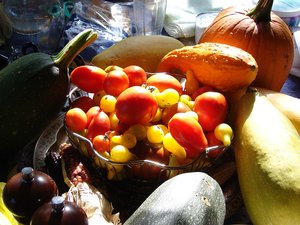Autumn Harvest is Good for Your Eyes
Every holiday season, Dr. Pinkerton and his family enjoy a traditional Thanksgiving meal followed by a themed Christmas feast. Last year’s was an Under the Sea theme celebrating Dr. P’s love of the ocean and seafood. This year’s theme will be Frontier Christmas, featuring foods available to early American settlers. At the end of today’s post by guest blogger and Chicago-based food writer Nicole Weddington is a recipe for a root vegetable casserole that may serve as a side dish (with modifications for authenticity) along with Colonial Game Pie made of duck, rabbit and venison.
By Nicole Weddington
 The fall is a great time to incorporate eye-healthy choices into recipes because many of the foods that we associate with autumn, as well as the upcoming holidays, just happen to be great for the eyes. Hearty squashes and green, leafy vegetables, as well as certain fruits and nuts, have properties that are helpful for vision as well as general health. Here we’ve compiled a list of fall ingredients that will get you on your way to clearer vision.
The fall is a great time to incorporate eye-healthy choices into recipes because many of the foods that we associate with autumn, as well as the upcoming holidays, just happen to be great for the eyes. Hearty squashes and green, leafy vegetables, as well as certain fruits and nuts, have properties that are helpful for vision as well as general health. Here we’ve compiled a list of fall ingredients that will get you on your way to clearer vision.
Pumpkin
Just one cup of cooked pumpkin contains 200 percent of the daily recommended dose of vitamin A in the form of beta carotene. Vitamin A is good for vision, particularly in dim light, and helps fight infection. Other foods rich in beta-carotene include kale, spinach, cabbage, carrots, sweet potatoes, collards, turnip greens, beet greens and butternut squash. In addition to aiding with vision, pumpkin can help with weight loss and heart health, and can boost your mood and reduce the risk of cancer.
Butternut squash
Once the beta carotene in this super food converts into vitamin A, it may help prevent dry eyes and night blindness. Squash also contains lutein and zeaxanthin, antioxidants that lower the risk of age-related eye disease and aid in the prevention of cataracts and macular degeneration.
Cranberries
Cranberries also may help promote vision and eye function due to the carotenoids they contain, although the amount of sugar people typically add to make them less tart diminishes their health benefits.
Turkey
Though generally not touted as an eye-healthy food, this Thanksgiving staple contains zinc, which reduces the risk of macular degeneration — loss of vision in the center of the visual field (the macula) because of damage to the retina. Other foods rich in zinc include eggs, yogurt, oats, pumpkin seeds and sesame seeds.
Try this variation on a traditional sweet potato dish this Thanksgiving for optimal eye health.
Sweet Potato Casserole with Carrots
Ingredients:
1/2 cup firmly packed brown sugar
1 teaspoon nutmet
1 1/2 pounds sweet potatoes, peeled and cut into 1-inch pieces (3 ½-4 cups)
1 ½ pounds carrots, peeled and cut into 1-inch pieces (3 ½-4 cups)
2 tablespoons orange juice
1 teaspoon vanilla extract
2 tablespoons butter, cut up
¼ cup pumpkin or sunflower seeds (pre-toasted, not salted)
Directions:
- Preheat oven to 350°F. Mix brown sugar and nutmeg in large bowl. Add sweet potatoes and carrots; toss well. Spread in 13×9-inch baking dish.
- Mix orange juice and vanilla; pour over sweet potatoes. Sprinkle with seeds. Dot with butter. Cover.
- Bake 40 minutes. Remove from oven and stir. Bake, uncovered, 15 to 20 minutes longer or until sweet potatoes and carrots are fork tender.
